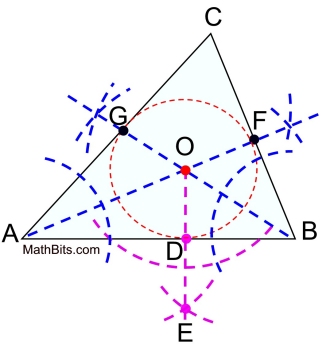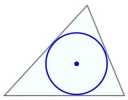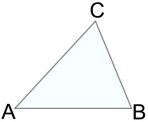Intuitively, the word "inscribed", in geometry, refers to one shape "fitting snugly"
inside of another geometric shape.
inscribed = inside See the discussion on "incenters" at Incenter - Concurrent ∠ Bisectors.
To determine the length of the radius, we will construct a perpendicular to one side of the triangle from the center point to get the actual length. We will be applying the theorem below, where the "tangent line" is the side of the triangle: Theorem: The radius of a circle drawn to the point of tangency (of a tangent line) is perpendicular to the tangent.
This construction will focus on the angle bisectors of the angles of the triangle. Remember the theorem: "If a point lies anywhere on an angle bisector, that point is equidistant from the two sides (rays) of the bisected angle." Where the angle bisectors intersect (say point O), will be used to establish that OD = OF = OG as the radii of a circle tangent to the sides of the triangle. STEPS:  Be careful with this construction. Accuracy is very important. If you want your circle to touch all three sides of the triangle, you will need to be as accurate as possible with each step in this construction. Remember, the circle should just touch each of the sides. • Why is it sufficient to only construct the angle bisectors for TWO of the angles in the triangle, instead of all three angles? Only two angle bisectors will be needed. We know OF = OD and OG = OD since any point on the angle bisector is equidistant from the sides (rays) of the angle. The substitution (or transitive) property gives us that OF = OG, and we have all three radii equidistant from the sides (rays) of the angles, OF = OG = OD. It is not necessary to have the third angle bisector, since we already know mathematically that OF = OG. Yes, you can construct the third angle bisector, if you wish, to verify the location of point O.
Proof of Construction: Since point O lies on the bisector of ∠A, point O is equidistant from
Topical Outline | Geometry Outline | MathBitsNotebook.com | MathBits' Teacher Resources
|



